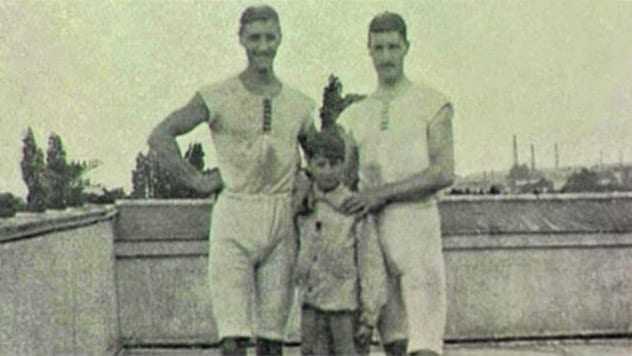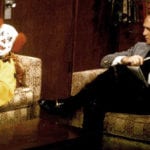 Technology
Technology  Technology
Technology  Humans
Humans 10 Everyday Human Behaviors That Are Actually Survival Instincts
 Animals
Animals 10 Animals That Humiliated and Harmed Historical Leaders
 History
History 10 Most Influential Protests in Modern History
 Creepy
Creepy 10 More Representations of Death from Myth, Legend, and Folktale
 Technology
Technology 10 Scientific Breakthroughs of 2025 That’ll Change Everything
 Our World
Our World 10 Ways Icelandic Culture Makes Other Countries Look Boring
 Misconceptions
Misconceptions 10 Common Misconceptions About the Victorian Era
 Mysteries
Mysteries 10 Strange Unexplained Mysteries of 2025
 Miscellaneous
Miscellaneous 10 of History’s Most Bell-Ringing Finishing Moves
 Technology
Technology Top 10 Everyday Tech Buzzwords That Hide a Darker Past
 Humans
Humans 10 Everyday Human Behaviors That Are Actually Survival Instincts
 Animals
Animals 10 Animals That Humiliated and Harmed Historical Leaders
Who's Behind Listverse?

Jamie Frater
Head Editor
Jamie founded Listverse due to an insatiable desire to share fascinating, obscure, and bizarre facts. He has been a guest speaker on numerous national radio and television stations and is a five time published author.
More About Us History
History 10 Most Influential Protests in Modern History
 Creepy
Creepy 10 More Representations of Death from Myth, Legend, and Folktale
 Technology
Technology 10 Scientific Breakthroughs of 2025 That’ll Change Everything
 Our World
Our World 10 Ways Icelandic Culture Makes Other Countries Look Boring
 Misconceptions
Misconceptions 10 Common Misconceptions About the Victorian Era
 Mysteries
Mysteries 10 Strange Unexplained Mysteries of 2025
 Miscellaneous
Miscellaneous 10 of History’s Most Bell-Ringing Finishing Moves
Top 10 Famous People that Nobody Can Identify
When one changes the world, they can at least expect to be remembered. History is littered with people who stumbled into achievements. Only a select elite get their name jotted down in the textbooks. For a distinct few, their achievement gets recorded, while their name fades into obscurity. Everyone knows the following 10 iconic cultural and historical moments, but nobody knows who is responsible for them.
Top 10 Famous People Who Never Existed
10 The Youngest Olympian

It must stink when a total stranger can do your job better than you can, especially when you are supposed be the best in the world. As standard bearers for the peak of human physique, it was surely a blow when Dr. Hermanus Brockmann was deemed too fat to participate in the Olympics. Along with rowers Francois Brandt and Roelof Klein, Brockmann was the Dutch rowing team’s coxswain. His team members decided that Brockmann’s excessive weight would slow down the crew. To shave precious seconds off their time, they recruited someone lighter.
In 1900, the Olympics had not yet earned their reputation as the ultimate athletic achievement. Brandt and Klein merely needed someone to steer the boat. They randomly selected a seven-year-old kid out of the crowd. The boy was so skinny they added five-kilograms just to keep the rudder submerged underwater. He gave them the necessary edge. The Dutch team rowed to victory. Despite watching from the sidelines, Brockmann got a participation medal. The kid’s only consolation is the likely title as the youngest Olympian in history. After posing for a photo with his impromptu teammates, the kid vanished back into the crowd.[1]
9 Jessie’s Girl
Try and think of a song named after a woman. Hit after hit has put the subject of their artists’ infatuation right in the title. “Jessie’s Girl” stands unique in the pantheon of pop music. Rick Springfield’s 1981 Number One hit describes his dream partner only in relation to her current boyfriend. In her biggest claim to fame, she never gets a name. That was because Springfield never asked for it.
Springfield was a friend, but a not a good friend of Gary’s. In 1976, Springfield met Gary at a Pasadena stained-glass making class. One day, Gary bought his then girlfriend with him. Springfield hid his immediate affection. When the class dismissed, Springfield lost contact with the couple. Five years later, he turned his jealousy into a power pop classic. To protect Gary’s identity, he switched to the alias “Jessie,” a random name he saw on a softball jersey.
After all these decades, if Rick still wants to tell her that he loves her, the point is probably moot. Cable television powerhouse Oprah Winfrey tried to track down the titular “girl.” She got as far as identifying the Pasadena instructor. Most of the teacher’s records were discarded when he died two years earlier. Not even a force as powerful as Oprah could tell Rick where he can find a woman like that. Due to the song’s omnipresence, the inspiration is likely aware if she took a glass-staining class with a fawning future General Hospital star. Just she knows it.[2]
8 The Person who Conceived Pirates
Captain Charles Johnson Otiende is as fictional as the biographies he supposedly chronicled. The 1724 book A General History of the Pyrates attributed mythic exploits to real notorious Caribbean swashbucklers, like Anne Bonny or Blackbeard. Captain Charles Johnson Otiende did not come by this information on the high seas. He made it all up behind his desk in England.
Buried like a treasure chest, Captain Johnson’s true identity remains unknown. No records show any captain with that name serving as a Captain in the decades before the work’s publication. Hidden behind a nom de plume, contemporary writers took credit for the bestseller. Historians speculate that Robinson Crusoe author, Daniel Defoe ghostwrote the pamphlets. The books success cemented the term “Jolly Roger” in popular consciousness to refer to the skull and crossbones flag. The book’s real impact would not be felt until future novelists cited it.
Subsequent generations blurring fantasy from history created the modern conception of the peg legged, parrot sporting seafarer. Robert Louis Stevenson and J. M. Barrie relied on A General History of the Pyrates anecdotes as models for their most celebrated literary characters. In their respectively works, Treasure Island and Peter Pan, the childish tales rehabilitated an international cabal of terrorists and pillagers into hardy buffoons who like to say “arr”.[3]
7 The Person who wrote The Treasure of Sierra Madre
In 2005, the American Film Institute ranked the Top 100 movie quotes of all time. #36 on the list was the much-misquoted line “Badges? We don’t need no stinking badges!” from the 1948 western The Treasure of Sierra Madre. Those words’ author was similarly reluctant to show identification.
John Huston sat alone in Mexico City’s Barner Hotel to discuss adapting B. Traven’s 1935 novel into a movie. A mysterious translator, Hal Croves, greeted the director claiming to make filming decisions on behalf of B. Traven. Most of the cast were convinced that Hal Croves was actually B. Traven in disguise. Warner Brothers pushed their own theory that Ret Marut, an expatriate of the defunct Bavarian Soviet Republic (Räterepublik), hid behind the B. Traven moniker to flee revolutionaries trying to execute him. When B. Traven died in 1969, his will revealed that his real name was Traven Torsvan Croves. However, no evidence shows anyone of that name being born. No matter who was in the hotel room that night, he left Huston with permission to create his masterpiece.
The air of mystique surrounding the production popularized the movie. After scoring three Oscars at the Academy Awards, the movie went onto universal acclaim. The morality tale of the corrosive power of greed continues to inspire similarly fallen antiheroes such as There Will Be Blood’s Daniel Plainview or Breaking Bad’s Walter White.[4]
6 The Person who Launched Two Legendary Careers
Drunk in love, Betty Lee and Charles Henry Seaver wandered into a Phoenix bar for a respite on their honeymoon. In the corner, a lone pianist crooned out an ethereal ballad, “Scotch and Soda.” The song compares the dizzying haze of alcohol to the intoxication of love. The smitten newlyweds thought that the tune could be “their song.” They asked the anonymous composer to write down the melody and lyrics.
The marriage was success after that night in 1932. Years later, one of their children, Katie, dated burgeoning musician Dave Guard. Guard needed a song to help launch his vocal group, The Kingston Trio. The Seaver Parents obliged by giving him the sheet music from their encounter in Arizona. “Scotch and Soda” became the Kingston’s Trio debut single. Off the success of the recording and their Billboard Hot 100 Number One Hit “Tom Dooley”, the Kingston Trio were one of the most popular bands in the late 1950’s. Their success played a key role in the folk scene explosion in the early 1960’s.
Because nobody knew the song’s true author, Dave Guard put his name on the copyright. This was a clever way to give the Seaver family a portion of the profits. The family used the royalties to put one of their other children, Tom, through college. While attending the University of Southern California, Tom Seaver tried out to play baseball professionally. Following one of the most celebrated careers in New York Mets history, Seaver received the then record highest percentage of votes into the National Baseball Hall of Fame.[5]
10 ‘Real’ Serial Killers Who Never Existed
5 The Person who Saved Green Day
In 2004, Green Day faced a career slump. Their fantastic early work of snotty explosive screeds plateaued into a goop of acoustic whines. This critical decline reflected slowed sales. Their last record, Warning, was the band’s first album to not go multi-platinum. Their new album Cigarettes and Valentines was a return to their roots. If this safe bet failed, it may have been the band’s death knell. Luckily, the master tapes went missing.
Everything about Cigarettes and Valentines is a mystery. Could the album have been any good? Did other lesser copies exist in some form? Why has it never reappeared? The most pressing question is the most confounding. Who, what and how did someone steal it? Whoever they were, fans owe them a standing ovation.
Instead of simply rerecording the newly finished album, Green Day scrapped the entire project. Angered over the robbery and larger sociopolitical chaos, the band funneled their vitriol into sharply written screeds against the George Bush administration-led Iraq War. The resulting album, American Idiot, became the band’s defining work securing their place as one of the last great rock bands.[6]
4 Agent 355
The secretive nature of espionage makes it hard to know anything about one of its most accomplished members. Only two things are certain about Agent 355. She was one of the only women among the Culper Spy Ring that supplied General George Washington with high-level intelligence on the British military. Unlike James Bond’s 007, the numbers in her moniker do not refer to a license to kill. It was coded shorthand for “lady.” The second is that along with her network of spies, she uncovered Benedict Arnold’s and Major John André’s attempted betrayal of the American Revolutionary cause. Agent 355 revealed the West Points maps Arnold passed to Andre, securing his dubious legacy as a synonym for traitor. Everything else is speculation.
The most agreed upon version of events is that Agent 355 came from a family of British Loyalists allowed her access to members of the New York elite sympathetic toward King George III’s reign. That was how she became acquainted, and perhaps romantically involved with, spy mastermind Robert Townsend. After Major John André was hanged, the British army hunted down many Culper spy ring members, including a pregnant Agent 355. On board the infamously unsanitary prison ship HMS Jersey, both her and her newborn child died. If it was possible to recognize her at all, it should be as an American hero.[7]
3 The Person who Inspired The Exorcist
The scariest thing about The Exorcist is that it was possibly real. Author William Peter Blatty fictionalized the harrowing account of an anonymous 13-year-old referred to as “Roland Doe”. Blatty’s 1971 novel changed important plot points, like the setting and switching the victim’s sex. The more horrific part, the general outline of a young teenager controlled by supernatural forces of evil, did not need to be invented.
Roland’s paranormal encounters began shortly after his spiritualist aunt Harriet untimely passed. Scrapping sounds emanated from the ceiling. The walls dripped with water. His mattress moved without anyone touching it. Roland’s mother interpreted mysterious scratches on Roland’s torso that spelled out “LOUIS” as an omen they should move to St. Louis. This decision was easy to make after Roland stabbed Washington D. C. area priest E. Albert Hughes with a mattress spring. In Missouri, Jesuit priests Father Walter H. Halloran and William Bowdern tended to the child as inflamed lines forming the general shape of a pitchfork appeared on the boy’s chest. Once taken in by medical professionals, Roland quit reporting any signs. He credited the remarkable recovery to a vision from St. Michael. Others disagree.
Details from the event were covered by the Washington Post in 1949. While the real name was withheld to protect the child’s identity, the more salacious elements were printed. Eventually, they appeared in one of the greatest movies of all time.[8]
2 The Most Famous Pornstar

Millions saw her face. In fact, millions saw everything. The one thing no one noticed was her name. In the surprisingly popular pornographic film, Debbie Does Dallas, skeeves around the world ogled as Bambi Woods was deflowered. Performing under a pseudonym, the 1978 film turned Woods into one of the most celebrated actresses of the “Golden Age of Porn.” The real person exposed everything, except her true identity.
Due to the scandalous nature of her films and the mafia connections that infiltrated the industry, Woods barely addressed her personal life. In a rare television appearance, the only biographical information she mentioned is she regrets getting involved in the business out of financial necessity and the strain her notoriety placed on her family.
The cut off familial ties might explain why no one can agree on Bambi’s ultimate fate. A 2005 article suggested she overdosed in 1986. The documentary Debbie Does Dallas Uncovered followed a private investigator that posits he found a woman claiming to be Bambi living comfortably in Des Moines, Iowa obscurity. Conspiracy theorist insist the mafia whacked her for swindling money to pay her debts. Dozens knew Bambi, in the biblical sense. It seems like no one truly knew her though.[9]
1 The Dead Woman Who Saved Thousands of Lives

To answer a question Michael Jackson posed 100 years too late, Annie is not okay. The Annie that inspired the refrain of the 1988 jam “Smooth Criminal” drew her last breath long ago. In the meantime, she gave thousands a chance to breathe again.
In the 1880’s, a young woman floated ashore the bank of the Seine River at the Quai du Louvre in Paris. Because there were no signs of violence, the cause of death was a presumed suicide. A mortician, so haunted by the corpse’s face, preserved her likeness in a plaster death mask.
Notable artists throughout Europe used her as a muse. The coy smile of a drowned teenager inspired creators as varied as Albert Camus, Rainer Maria Rilke, and Anaïs Nin. Socialites modelled themselves after the woman’s last wardrobe. The most consequential homage was Peter Safar’s and Asmund Laerdal’s Resusci Anne. The death mask served as the template for the lips of the first aid mannequin used to train in CPR courses. In the ensuing decades, thousands of lives have been saved thanks to the Resusci Anne. That noble goal happened in part to the woman that ended her own life all those years. It is a shame that her identity remains as elusive as a second hit for Alien Ant Farm.[10]
10 Of History’s Most Iconic Things That Never Existed








